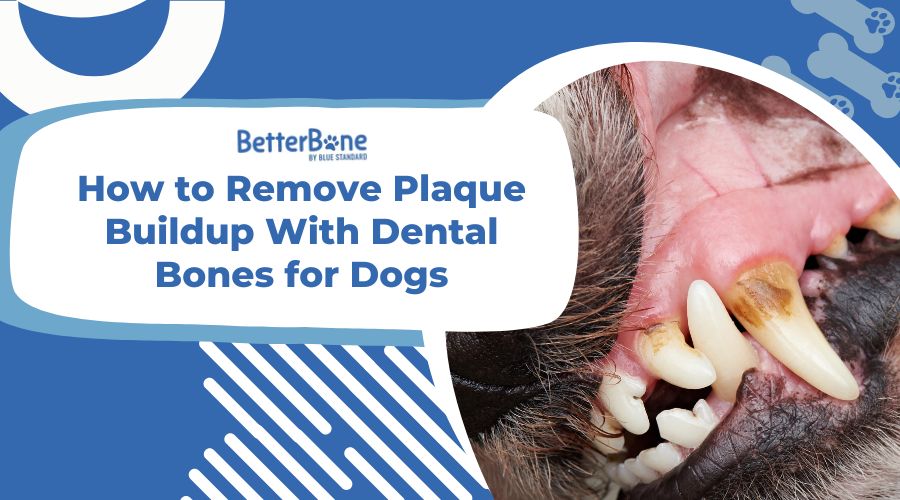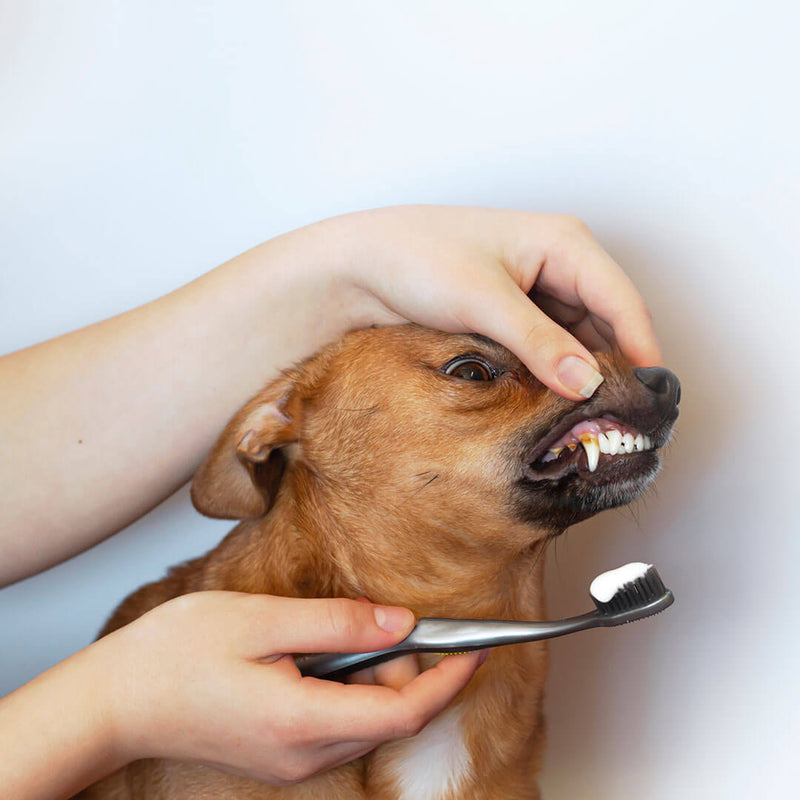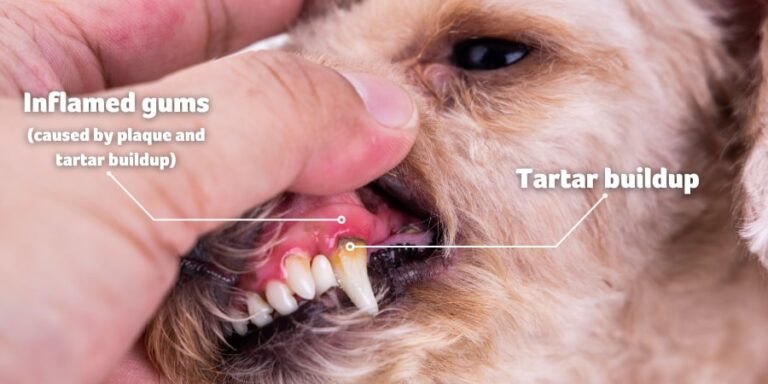To remove plaque from a dog’s teeth, brush them regularly and provide dental chews to help control plaque buildup. Plaque is a common issue in canine dental care, but with consistent brushing and the right chews, it can be effectively managed.
Dental health is crucial for dogs, and plaque buildup can lead to serious issues like gum disease and tooth decay. We will explore the importance of dental care for dogs and provide practical tips on how to remove plaque from your furry friend’s teeth.
By following these simple steps, you can ensure that your dog maintains good oral hygiene and overall well-being. Let’s dive into the details of proper dental care for your canine companion to keep their teeth clean and healthy.

Credit: ingenious-probiotics.com
Why Plaque Is A Problem
Plaque buildup is a common issue for dogs, leading to dental problems. Discover effective methods to remove plaque from your dog’s teeth, promoting their oral health and overall well-being.
The Dangers Of Plaque Buildup
Plaque buildup on a dog’s teeth can lead to a range of health problems that can significantly impact their quality of life. Understanding the dangers associated with plaque is crucial in order to take proper care of your furry friend’s dental health.
Understanding The Causes Of Plaque
Plaque is a sticky, colorless film that forms on the teeth. It is primarily caused by the bacteria present in your dog’s mouth. When your dog eats, food particles mix with saliva to form a sticky substance that sticks to the teeth. Over time, this substance hardens and turns into plaque.
There are several factors that contribute to the formation of plaque:
- Poor dental hygiene: Just like with humans, poor dental hygiene is a major cause of plaque buildup in dogs. Skipping regular teeth brushing or neglecting to provide chew toys or dental treats can lead to the accumulation of plaque.
- Diet: Certain types of food, especially those high in carbohydrates and sugars, can promote plaque formation. Sticky foods that cling to the teeth are particularly problematic, as they provide an ideal environment for plaque-causing bacteria to thrive.
- Predisposition to dental issues: Some dog breeds are more prone to dental problems, including plaque buildup. Breeds with crowded or misaligned teeth, such as Bulldogs or Pugs, are at a higher risk.
- Lack of professional dental care: Without regular visits to the veterinarian for dental cleanings, plaque can continue to accumulate and contribute to dental disease.
It is important to pay attention to the buildup of plaque on your dog’s teeth and take prompt action to prevent further complications. If left untreated, plaque can progress to tartar, which is a hardened form of plaque that firmly attaches to the tooth surface. This can lead to a condition called periodontal disease.
Identifying Plaque In Dogs
It’s essential to recognize the signs of plaque in dogs to ensure their dental health. By understanding the common indicators and knowing how to check for plaque, you can take proactive measures to prevent dental issues in your canine companion.
Common Signs Of Plaque In Dogs
Before you can effectively address plaque in your dog’s teeth, it’s crucial to be aware of the common signs that may indicate its presence. Keep an eye out for the following indicators of plaque:
- Foul breath
- Yellow or brown discoloration on teeth
- Difficulty chewing or eating
- Excessive drooling
How To Check For Plaque
Regularly inspecting your dog’s teeth is an important part of maintaining their dental hygiene. Here’s how you can check for plaque:
- Hold your dog’s mouth open gently
- Look for any yellow or brown buildup on the teeth
- Feel for rough, gritty textures on the teeth surface
By staying vigilant and taking proactive measures, you can help ensure that your furry friend maintains a healthy, plaque-free smile!
Preventing Plaque In Dogs
Dog owners know the importance of maintaining their pet’s dental health. One common issue that affects dogs is plaque buildup, which can lead to serious dental problems if not properly managed. Fortunately, there are several effective ways to prevent plaque in dogs, ensuring they have healthy teeth and gums for years to come.
Importance Of Regular Dental Care
Regular dental care is crucial for preventing plaque buildup in dogs. Just like humans, dogs need to have their teeth brushed regularly to remove plaque and prevent tartar from forming. Additionally, routine dental check-ups with a veterinarian can help identify any potential issues early on, ensuring timely intervention and treatment.
Choosing The Right Diet For Dental Health
The diet plays a significant role in the dental health of dogs. It’s essential to choose dog food that is specially formulated to promote dental health, such as options designed to reduce tartar and plaque accumulation. Additionally, incorporating dental chews or treats that help clean the teeth can contribute to better oral hygiene for your furry friend.
Effective Dental Hygiene Routines For Dogs
Incorporating an effective dental hygiene routine is essential for preventing plaque in dogs. Brushing their teeth with dog-specific toothpaste on a regular basis, ideally daily, can help remove plaque and prevent tartar buildup. Furthermore, providing them with dental toys and chews designed to clean their teeth can supplement their oral hygiene routine.

Credit: thebetterbone.com
Home Remedies For Removing Plaque
Discover effective home remedies for removing plaque from your dog’s teeth. Maintain your pet’s oral health with these natural solutions.
Natural Remedies For Plaque Removal
To maintain your dog’s oral health and remove plaque at home, you can try some natural remedies. These alternatives are not only effective but also safe for your furry friend. Here are a few natural remedies for plaque removal:1. Coconut oil
Using coconut oil as a natural remedy for plaque removal can be beneficial. Its antimicrobial properties help reduce bacteria in the mouth, preventing plaque buildup. Simply apply a small amount of coconut oil to your dog’s teeth and gums, gently massaging it for a few minutes. This will not only help remove plaque but also freshen their breath.2. Turmeric paste
Turmeric is a powerful spice with anti-inflammatory and antimicrobial properties. By creating a paste of turmeric powder and water, you can effectively combat plaque. Apply the paste to your dog’s teeth, gently massaging it into their gums. Allow it to sit for a few minutes before rinsing off. Not only will this help remove plaque, but it will also promote healthy gums.3. Parsley
Parsley is not only a flavorful herb but also an excellent natural remedy for plaque removal. Its antibacterial properties help eliminate bacteria and freshen your dog’s breath. Chop a few fresh parsley leaves and sprinkle them over your dog’s food. Alternatively, you can steep the leaves in hot water, allow it to cool, and use the parsley-infused water as a mouth rinse for your pup.Brushing Your Dog’s Teeth At Home
Regularly brushing your dog’s teeth is one of the most effective ways to remove plaque and maintain their dental health. Here’s how you can brush your dog’s teeth at home:1. Choose the right toothbrush and toothpaste
Invest in a toothbrush specifically designed for dogs. These toothbrushes usually have softer bristles and are more comfortable for your furry friend. Additionally, use toothpaste formulated for dogs, as human toothpaste can be harmful to them.2. Introduce your dog to the process
Start by allowing your dog to sniff and lick the toothpaste, familiarizing them with the taste. Gradually introduce the toothbrush, allowing them to get used to the sensation before proceeding.3. Begin brushing
Gently lift your dog’s lips, exposing their teeth and gums. Using a 45-degree angle, brush their teeth in small circular motions, focusing on the gum line where plaque tends to accumulate. Be patient and gradually increase the brushing time as your dog becomes more comfortable.4. Reward and praise
After brushing, reward your dog with a treat or praise to create a positive association with the process. This will encourage them to cooperate during future brushing sessions.Using Dental Chews And Toys
Dental chews and toys can also help remove plaque buildup in your dog’s teeth. These products are specifically designed to massage their gums, scrape off plaque, and freshen their breath. Here’s how you can incorporate dental chews and toys into your dog’s oral care routine:1. Choose the right dental chew or toy
Opt for dental chews and toys that are specifically designed for plaque removal. Look for products with ridges and nubs that can effectively scrape off plaque while your dog chews and plays.2. Offer dental chews regularly
Make dental chews a part of your dog’s daily routine. You can replace regular treats with dental chews to ensure their teeth stay clean and healthy.3. Monitor your dog during chew time
While dental chews and toys are beneficial, it’s important to supervise your dog while they indulge in chew time. This will prevent any choking hazards and ensure they use the chew appropriately. Remember, consistent dental care is essential to maintain your dog’s oral health. By trying these home remedies, brushing their teeth regularly, and incorporating dental chews and toys into their routine, you can effectively remove plaque and keep their teeth clean and healthy.Professional Dental Cleaning For Dogs
If you have noticed your furry friend’s teeth covered in plaque, it may be time to consider a professional dental cleaning. While regular at-home toothbrushing and dental chews can help maintain your dog’s oral health, sometimes a deeper cleaning procedure is necessary. Professional dental cleaning for dogs can be an effective way to remove plaque and tartar build-up, ensuring your pup’s teeth stay healthy and strong.
When To Consider Professional Cleaning
There are several signs that indicate your dog may need a professional dental cleaning. These include:
- Bad breath
- Yellow or brown discoloration on the teeth
- Bleeding or inflamed gums
- Difficulty eating or loss of appetite
If you notice any of these symptoms, it’s important to have your dog’s teeth examined by a veterinarian. They can determine if a professional cleaning is necessary and recommend the best course of action.
What To Expect During A Dental Cleaning
During a professional dental cleaning, your dog will receive comprehensive oral care to remove plaque and tartar. The procedure typically involves the following steps:
- Anesthesia: To ensure your dog’s comfort and safety, they will be placed under anesthesia for the duration of the cleaning.
- Examination: A thorough examination of your dog’s teeth and gums will be conducted to assess the overall oral health and identify any underlying issues.
- Scaling: The dental professional will use specialized tools to carefully scrape away the plaque and tartar that has accumulated on the teeth above and below the gumline. This helps prevent dental disease and other oral issues.
- Polishing: After scaling, the teeth will be polished to smooth the surfaces and minimize the likelihood of future plaque build-up.
- X-rays (if necessary): In some cases, X-rays may be taken to evaluate the health of the teeth below the gumline. This helps identify any potential problems, such as abscesses or fractures.
Follow-up Care After Dental Cleaning
Once the dental cleaning is complete, your veterinarian will provide instructions for follow-up care. This may include:
- Antibiotics: If there was any sign of infection or inflammation, your dog may be prescribed antibiotics.
- At-home dental care: Regular toothbrushing and the use of dental chews or rinses can help maintain your dog’s oral health.
- Regular check-ups: Your veterinarian may recommend scheduling regular dental exams to monitor your dog’s oral health and address any potential issues before they worsen.
By following these post-cleaning care instructions, you can help ensure the long-term success of your dog’s dental cleaning and keep their teeth in tip-top shape.

Credit: petzpark.com.au
Frequently Asked Questions On How To Remove Plaque From A Dog’s Teeth
How Can I Remove Plaque From My Dog’s Teeth?
To remove plaque from your dog’s teeth, you can start by brushing their teeth regularly with a dog-friendly toothpaste and toothbrush. You can also provide dental chews and toys that help reduce plaque build-up. Regular dental check-ups by a veterinarian are crucial for professional cleaning and managing dental hygiene.
Are There Any Home Remedies To Remove Plaque From A Dog’s Teeth?
While regular brushing is the most effective way to remove plaque, you can also try natural remedies like adding coconut oil to your dog’s food or using a solution of water and hydrogen peroxide to rinse their mouth. However, always consult with your veterinarian before trying any home remedies.
Why Is Plaque Removal Important For My Dog’s Oral Health?
Plaque build-up on a dog’s teeth can lead to dental problems such as tooth decay, gum disease, and bad breath. If left untreated, these issues can cause pain, difficulty eating, and even systemic health problems. Regular plaque removal helps maintain your dog’s oral health and overall well-being.
Conclusion
To maintain your dog’s oral health, removing plaque is essential. By following the simple steps outlined in this blog post, you can ensure a happy and healthy smile for your furry friend. Regular brushing, dental treats, and professional cleanings are all effective methods to combat plaque buildup.
Remember, prevention is key, so be proactive in implementing these strategies. Your dog will thank you with a wagging tail and sparkling teeth!



